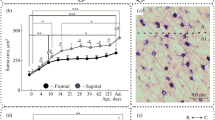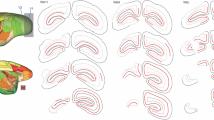Summary
The optic pathways of the mouse have been studied by tracing of degenerating fibers after enucleation and coagulation of the lateral geniculate nucleus. The effects of unilateral enucleation at birth in the contralateral area striata of the mouse have been studied with the Golgi method. The number of spines on three different portions of the apical dendrites of layer V pyramidal cells have been counted in the affected area striata of mice 24 and 48 days old enucleated at birth. The results were compared with the countings obtained in the area striata homolateral to the enucleated side and with controls of the same ages. The results indicated that enucleation produces, through a series of transneuronal changes, significant diminution of the number of spines in the apical dendritic segments located in layer IV. The diminution of dendritic spines is more pronounced in younger animals. Specific variations in the orientation of dendrites of stellate cells with ascending axons have been observed in enucleated animals. The significance of these findings has been discussed suggesting the existence of compensatory mechanisms which affect significantly the intrinsic organization of the area striata.
Similar content being viewed by others
References
Bennett, B.L., M.C. Diamond, D. Krech and M.R. Rosenzweig: Chemical and anatomical plasticity of brain. Science 146, 610–619 (1964).
Brodmann, K.: Beiträge zur histologisehen Lokalisation der Großhirnrinde. Der Calcarinatypus. J. Psychol. Neurol. (Lpz.) 2, 133–159 (1903).
Cajal, S.R.: A propos de certains éléments bipolaires du cervelet avec quelques détails nouveaux sur l'évolution des fibres cérébelleuses. J. internat. d'Anat. Physiol. 7, 1–22 (1890).
—: La rétine des vertébrés. Cellule 9, 121–257 (1893).
—: Histologie du système nerveux de l'homme et des vertébrés, vol. II. Paris: A. Maloine 1911. Reimpress. Madrid: Instituto Cajal 1955.
—: Textura de la corteza visual del gato. Trab. Lab. invest. biol., Univ. Madrid 19, 113–144 (1921).
Coleman, P.D.: Effects of rearing in the dark on dendritic fields of stellate cells in visual cortex. Communication presented at the Meeting of the Amer. Ass. Adv. Sci. Berkeley, California. Dec. 28 (1965).
Colonnier, M.: Experimental degeneration in the cerebral cortex. J. Anat. (Lond.) 98, 47–53 (1964).
—: The structural design of the neocortex. In: Brain and conscious experience. Ed. by J.C. Eccles, pp. 1–23. Berlin-Heidelberg-New York: Springer 1966.
Donaldson, H.H.: Anatomical observations on the brain and several sense organs of the blind deaf-mute, Laura Dewey Bridgman. Amer. J. Psychol. 3, 293–342 and 4, 248–294 (1890).
Fink, R.P., and L. Heimer: Two methods for selective silver impregnation of degenerating axons and their synaptic endings in the central nervous system. Brain Res. 4, 369–374 (1967).
Globus, A., and A.B. Scheibel: Synaptic loci on visual cortical neurons of the rabbit: the specific afferent radiation. Exp. Neurol. 18, 116–131 (1967).
Gray, E.G.: Axo-somatic and axo-dendritic synapses of the cerebral cortex: an electron microscope study. J. Anat. (Lond.) 93, 420–433 (1959).
— and V.P. Whittaker: The isolation of synaptic vesicles from the central nervous system. J. Physiol. (Lond.) 153, 35–37 (1960).
—: The isolation of nerve endings from brain: an electron-microscopic study of cell fragments derived by homogenization and centrifugation. J. Anat. (Lond.) 96, 79–88 (1962).
Groot, J. de: The rat forebrain in stereotaxic coordinates. Ver. Konink. Nederl. Akad. Wetensch., Natuurk. Tweede Reeks, 52, 4, 40 (1959).
Gyllensten, L.: Postnatal development of the visual cortex in darkness (mice). Acta morph. neerl.-scand. 2, 331–345 (1959).
Hess, A.: Optic centers and pathways after eye removal in fetal guinea pigs. J. comp. Neurol. 109, 91–115 (1958).
Hubel, D.H., and T.N. Wiesel: Receptive fields of cells in striate cortex of very young, visually inexperienced kittens. J. Neurophysiol. 26, 994–1002 (1963).
König, J.F.R., and R.A. Klippel: The rat brain. A stereotaxic atlas of the forebrain and lower parts of the brain stem. Baltimore: Williams and Wilkins Co. 1963.
Krech, D., M.R. Rosenzweig and E.L. Bennett: Effects of complex environment and blindness on rat brain. Arch. Neurol. 8, 403–412 (1963).
Levi-Montalcini, R.: The development of the acoustico-vestibular centers in the chick embryo in the absence of the afferent root fibers and of descending tracts. J. comp. Neurol. 91, 209–242 (1949).
Lindner, I., and K. Umrath: Veränderungen der Sehsphäre I und II in ihrem monokularen und binokularen Teil nach Extirpation eines Auges beim Kaninchen. Dtsch. Z. Nervenheilk. 172, 495–525 (1955).
Matthews, M.R., W.M. Cowan and T.P.S. Powell: Transneuronal cell degeneration in the lateral geniculate nucleus of the macaque monkey. J. Anat. (Lond.) 94, 145–169 (1960).
Minkowski, M.: über den Verlauf, die Endigung und die zentrale Repräsentation von gekreuzten und ungekreuzten Sehnervenfasern bei einigen Säugetieren und beim Menschen. Schweiz. Arch. Neurol. Psychiat. 6, 201–252 and 7, 268–303 (1920).
Nauta, W.J.H., and P.A. Gygax: Silver impregnation of degenerating axons in the central nervous system: a modified technic. Stain Teehnol. 29, 91–93 (1954).
Polyak, S.: The vertebrate visual system. Ed. by H. Klüver. Chicago: University of Chicago Press 1957.
Rose, M.: Cytoarchitektonischer Atlas der Großhirnrinde der Maus. J. Psychol. Neurol. (Lpz.) 40 1–51 (1929).
Tsang, Y.-C.: Visual centers in blinded rats. J. comp. Neurol. 66, 211–261 (1937).
Valverde, F.: Studies on the piriform lobe. Cambridge: Harvard University Press 1965.
—: Apical dendritic spines of the visual cortex and light deprivation in the mouse. Exp. Brain Res. 3, 337–352 (1967).
Walberg, F.: Role of normal dendrites in removal of degenerating terminal boutons. Exp. Neurol. 8, 112–124 (1963).
Wiesel, T.N., and D.H. Hubel: Effects of visual deprivation on morphology and physiology of cells in the cat's lateral geniculate body. J. Neurophysiol. 26, 978–993 (1963a).
—: Single-cell responses in striate cortex of kittens deprived of vision in one eye. J. Neurophysiol. 26, 1003–1017 (1963b).
Zeman, W., and J.R.M. Innes: Craigie's neuroanatomy of the rat. Revised and expanded. New York: Academic Press 1963.
Author information
Authors and Affiliations
Rights and permissions
About this article
Cite this article
Valverde, F. Structural changes in the area striata of the mouse after enucleation. Exp Brain Res 5, 274–292 (1968). https://doi.org/10.1007/BF00235903
Received:
Issue Date:
DOI: https://doi.org/10.1007/BF00235903




